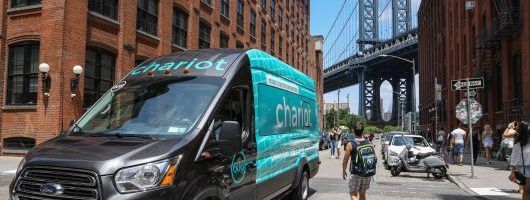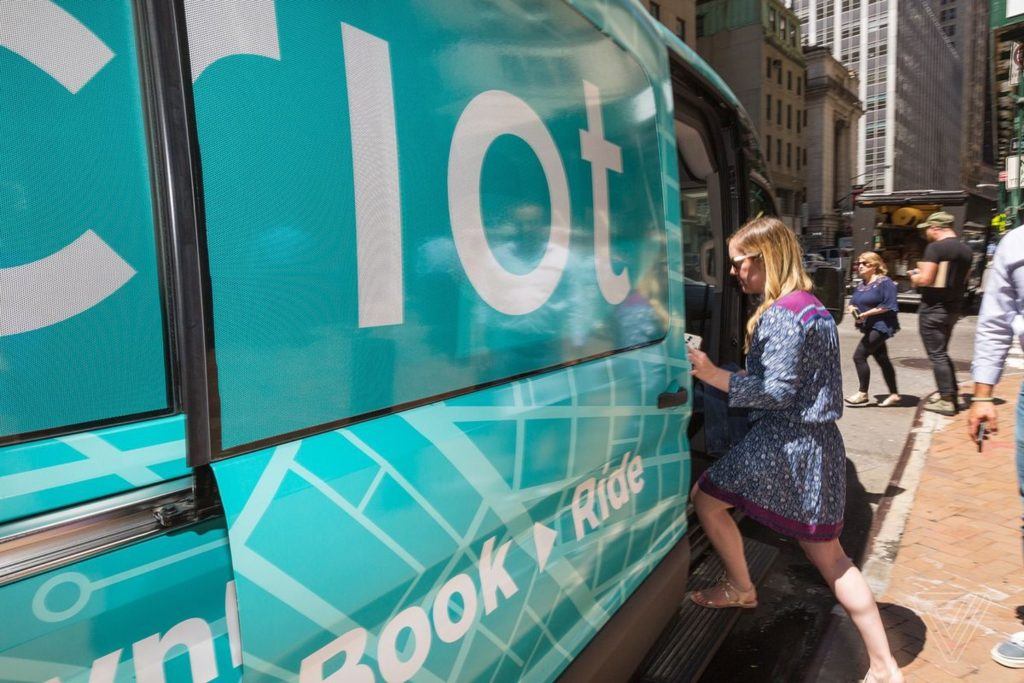Chariot: Changing Transit through Crowdsourced Co-Creation

Chariot offers an innovative, yet simple solution to designing city commutes: asking their riders where they want to go.
As technology innovations emerge at a rapidly increasing pace, many organizations are embracing the concept of “open innovation,” reaching outside their own walls to seek new ideas from collaborators, competitors, or their own users. As scholars Karim Lakhani and Jill Panetta noted, “the essential knowledge problem that faces many enterprises today is that in any given sphere of activity, most of the pertinent knowledge will reside outside the boundaries of any one organization…those charged with the innovation mission is to find ways to access that knowledge” [1]. Moreover, Lakhani and Panetta emphasize how critical users can be as sources for innovation and change as “they experience novel needs well ahead of manufacturers” [2]. While many companies have taken this to heart, organizations in the transportation sector have traditionally taken a “tops-down” approach. When building complex transit systems that carry passengers between a variety of pre-planned points in a city, government agencies often focus on infrastructure, costs and regulation; crowd-sourcing ideas from users is not top of mind.
New app-based transportation services are changing that notion, bringing open innovation to the sector. One example is Chariot, a crowdsourced commuter shuttle service that started in San Francisco in 2014. Chariot offers a fleet of 14-seater vans that aim to “solve commuting” by improving the rider experience and addressing service gaps ignored by existing transport solutions. Riders purchase tickets through an app, guaranteeing them a seat and offering a more pleasant experience than squeezing into a crowded bus. Perhaps most importantly, Chariot crowdsources information from their riders to help inform their routes and ultimately co-create their product.
Chariot does this in two ways: firstly, they use algorithms to develop transit routes based on user demand; secondly, they directly ask riders to pitch and vote on new routes. If a proposal gets 49 supporters within a month, Chariot can launch the new route within a week [3]. Chariot’s founder Ali Vahabzadeh summarized the importance of crowdsourcing to inform product development: “Why are we standing at the table, master-planning what the second, third and fourth route should be? We should just let the public tell us what the next service area should be through a popularity contest” [4]. Crowdsourcing also allows Chariot to be intentional and quick to market with new commuter routes. Co-creation with their users eliminates unnecessary time or money spent researching or testing routes; rather, they give their customers the routes they want and will thus very likely use. Crowdsourcing information also allows Chariot to iterate quickly, making service changes or filling gaps in real time—something traditional transport agencies cannot do.
In the short-term, Chariot’s leadership team hopes to leverage their crowdsourcing approach to product development to reach a broader customer base. Today, most of Chariot’s riders are wealthier, tech-savvy urbanites [5]. In the next few years, Vahabzadeh wants to include more customers who lack credit cards, bank accounts and smart phones: “We want to be a solution for 100 percent of consumers, not just people who can afford a smartphone and a bank account” [6]. Longer term, the Chariot team hopes to use their success with open innovation to develop partnerships with governments and cities. Beyond offering faster and more agile transit solutions, Chariot can provide crowdsourced data that will help cities get smarter over the next ten years, laying the groundwork for flexible innovations that will better serve the transportation demands of their inhabitants [7].
In mid-2016, Chariot was acquired by Ford Smart Mobility, a subsidiary of Ford Motor Company. For Ford, Chariot is the “cornerstone of its shuttle and mobility programs in cities going forward”; for Chariot, Ford’s expertise and resources provide the “ability to ramp up quickly and increase the pace of expansion” [8]. Since the acquisition, Ford has expanded Chariot to 10 additional cities, including Austin, Detroit, New York and London [9]. While this partnership offers synergies for both companies, Chariot should be careful to maintain crowdsourcing as a critical component of product development as they quickly enter new markets with new consumers who have unique commuting challenges. Additionally, Ford might consider how to incorporate crowdsourcing into its more traditional products—particularly as trends such as growing urbanization and self-driving cars are poised to disrupt vehicle ownership.
Despite Chariot’s success thus far, open questions certainly remain around the future of crowdsourcing and innovation in the transit space. Should larger, more traditional transit companies (e.g. Ford) adopt Chariot’s approach to co-creation with their users? Should transit agencies run by the government adopt such an approach? In what instances should crowdsourcing be avoided? Turning to Chariot’s future: as more innovative app-based transportation solutions (e.g. rideshares) come to market and gain popularity, can open innovation help Chariot maintain its foothold? (781 words).
[1] K. Lakhani and J. Panetta. The principles of distributed innovation. Innovations: Technology, Governance, Globalization 2, no. 3 (Summer 2007): 97–112.
[2] See note [1].
[3] “Start-ups Find Footing with Crowdsourced Bus Service in Cities with Ailing Transit.” 2017. The Washington Post. https://www.washingtonpost.com/local/trafficandcommuting/start-ups-find-footing-with-crowdsourced-bus-service-in-cities-with-ailing-transit/2017/09/02/c8920cca-8c1c-11e7-91d5-ab4e4bb76a3a_story.html?noredirect=on&utm_term=.734dc45b048a.
[4] “Can Ford Fix New York City’s Transportation Crisis with a Crowdsourced Shuttle Bus?” 2017. The Verge. https://www.theverge.com/2017/7/27/16036082/ford-chariot-nyc-crowdsource-microtransit-shuttle-bus.
[5] See note [4].
[6] See note [4].
[7] See note [4].
[8] “Ford Smart Mobility Acquires Chariot to Boost Smart City Transit Plans.” 2016. TechCrunch. https://techcrunch.com/2016/09/09/ford-mobility-solutions-acquires-chariot/
[9] “Crowdsourcing the Commute.” 2018. The New York Times. https://www.nytimes.com/2018/01/10/nyregion/crowdsourcing-the-commute.html




It’s really interesting to see what Chariot is doing. However, I wonder whether they are genuine about crowd-sourcing as a solution to solve their customer challenges as opposed to a marketing tactic to get buy-in from consumers. As a marketing tactic, I think it is fantastic. By getting users to vote on a location, they are highly likely to establish loyalty and regular use whilst also building a network of customers who serve as brand promoters.
Certainly, this approach of seeking consumer input would a great example for businesses and governments to consider. However, if they genuinely want to produce better solutions, I would challenge these organizations to identify the problems that customers are more equipped to solve and put these problems in the hands of customers.
It is interesting to think of Chariot using open innovation in 2014 before Uber and Lyft had gained significant awareness in the U.S. While it seems like it (Chariot) would have been very innovative at the time, I’d be curious to see how it remained competitive as Uber and Lyft entered the market – especially after they began offering their lower-cost pool options. Would Chariot have had to adopt its business model significantly? Or, would it have scaled to an extent where it could group large quantities of people in a bus-like system and position itself as the lowest-cost option? I will certainly look into it to see what actually happened!
Either way, I think the principle of getting input from your customers on what they want is a concept that could be applied to any local transportation company, even those with more of an Uber-like model.
Great post, I really enjoyed reading it. I am curious if their process of learning from their customers is more accurate than Uber’s data analysis. While I agree if people feel like they are contributing then they will assume things are better but in the long run if routes are less efficient I can’t see how Chariot wins.
Chariot has an interesting model, especially given the competitive nature of the ridesharing space. While I do think crowdsourcing is valuable for product selection (i.e. route identification), Chariot’s downfall is with missed opportunities given timing. Say I’m a commuter looking for a new route. I indicate my interest and have to sit back until my route is supported by 49 users. That could take a few days but it may also take a few months (assumption). As a commuter, I still have to get to work so I have to figure out how to get there in the meantime. Once I get into my commuting habit, I may not want to break out of it so that means lost revenue for Chariot. This is all to say that Chariot should leverage crowdsourcing for information but shouldn’t have their entire business model be contingent on it because of these “lost waiting commuters.”
Lastly, Chariot could potentially consider partnering with the government to offer another option for commuters. Public transportation is already severely strained in many populous cities (e.g. NYC). As such many commuters have opted to pay more to take private Ubers/Lyfts to work in order to have a more pleasant commuting experience. This is very costly. A partnership with Chariot could mean prices that are between subway and Uber/Lyft prices which may be enough to convert a good portion of the commuter base.
Co-creation is the new norm in products of all types–and I expect transportation to be no exception. Though more morose, government and Big Auto will, too, begin to lower the barriers to getting good, timely feedback from customers both on existing services and upcoming ones. Who doesn’t benefit from knowing better what their customers/users want? The only caution that warrants adding is that popularity may not always equal the best next-step; a detailed understanding of operational challenges and expected return are needed before greenlighting new offerings.
Interesting post. I am curious how Chariot / Ford evaluates efficiency and profitability before and after implementation of each contemplated route. ~49 riders per route seems like a low bar… As Chariot has become more established, did the criteria to establish new routes rise significantly? If the barriers to innovation increase, does the user eventually lose confidence in the open-source model, and become disillusioned with Chariot overall?